HowIDo
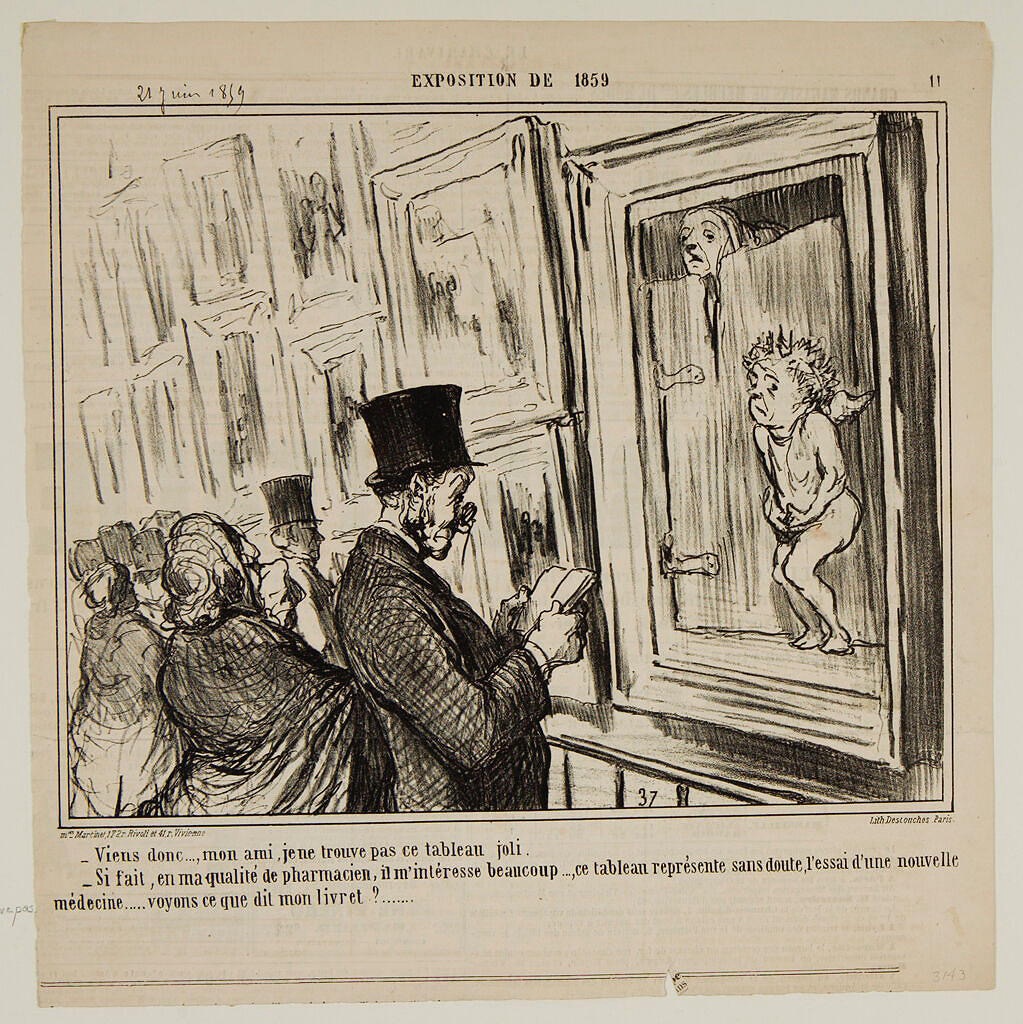
Honoré-Victorin Daumier:
"Let's go..., my friend, I do not find this painting pretty..."
From the book:
L' Exposition de 1859, 11 (Le Charivari, 21 June 1859)
Original Language Title:
"Viens donc..., mon ami, je ne trouve pas..." (1859)
Writing, like all activities, has little to do with itself. The activity of writing seems almost beside the point, for much context-setting and content-framing work must occur before writing can productively commence. These set-up activities sometimes prove insurmountable, especially if a writer cannot transform many into rote routines or preparatory rituals. I think of my writing set-up routine as sacred since all I produce must first pass through it. Without it, I could produce precisely nothing, so my HowIDo explanation seems worthy of perhaps even an overly wordy presentation with pictures. Here come some picky details:
Who knows where the idea of a story originates? I as author must be the very last one to know. I explain that the ideas visit me, and only sometimes easily. Some mornings, I catch myself wracking my brain for ideas, a technique that, as near as I can determine, successfully chases off any potentially useable idea. I usually set a trap. I avoid trying to find a title, a negative sort of effort, until some possible title slips in. They almost always come to me this way. I must distract myself from trying in order to attract some inspiration. The first hour of my morning usually involves meditating, emptying my monkey mind, and deliberately not trying. Some idea usually slips in.
I brew myself a bowl of coffee with my stovetop espresso maker, Italian Roast Decaf, then wend my way up to my office in the dark. It's three or four am by then, and I open up my RapidWeaver application on my MacBook Air and set about setting up the story. I search the entries in my blog history to see if I've already used the title that visited me. If I find a match, I must select something else because duplicates cause compiling trouble, usually in the form of some past image appearing in the current story. I can fix this difficulty, but it’s a hassle, so I've become wary and careful. About every fortnight or so, I still manage to duplicate some titles because I used to store my stories wrong, so my diligent search through the formal history doesn't always prevent me from repeating some names from the distant past. If I deleted my older entries, I wouldn't have this difficulty, but I can't. I just can't.
If the name passes muster, I create a new entry for that day's story. Today's story I've titled HowIDo, so that name becomes the entry's Title, Permalink, and Social Tag titles. I add Category and Tag information and a brief description of what I intend the content to include. I paste in a stored copyright notice before setting out to find a suitable image for the story. I used to employ a simple Google Image Search to find images, but then I discovered Museo, a special-purpose image search engine created by a brilliant developer, Chase McCoy. He and I have corresponded on those rare occasions when his engine flakes out, always when one of the museums he searches changes their search parameters without notice. Museo displays dozens of images, most open source and beyond copyright. I remain careful never to use copyrighted images. If I want my copyright respected, I must respect others.
I use an image because it sets a tone. It serves as inspiration for what I will be writing. Sometimes, it seems clearly related to the subject, but not always. It might represent a twisted metaphor, but it always sets that tone. I want my stories to seep civility and appear classy, whatever else they transmit. Here's an example of me using Museo to find the image for this story: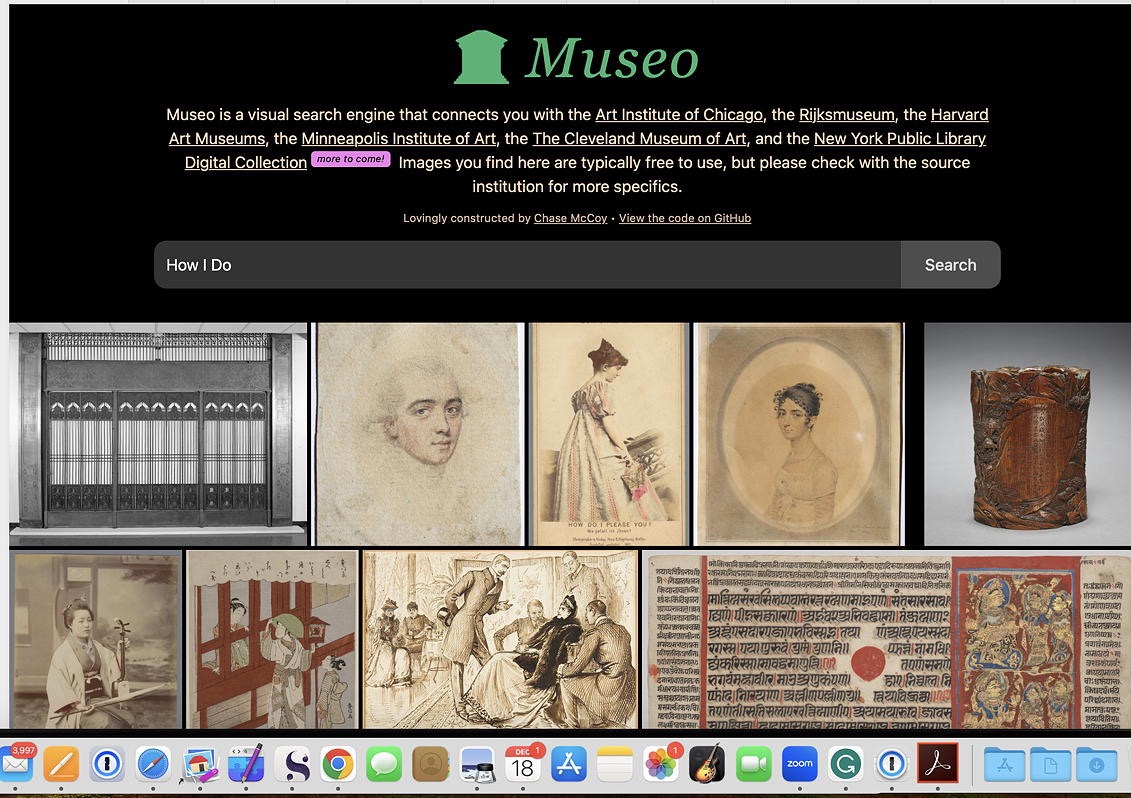
Searching for Suitable Image With Museo
Museo serves up pages of prospective images I just scroll through. I can click on any image to bring it up in a separate tab indexed by the image's source page. I might click through a dozen without finding anything satisfying. Often, though, the first image delivered serves my purpose. Other times, I might spend a half hour or more sorting through proffered images before finding one that satisfies my purpose. Once found, a subroutine of my ritual kicks in: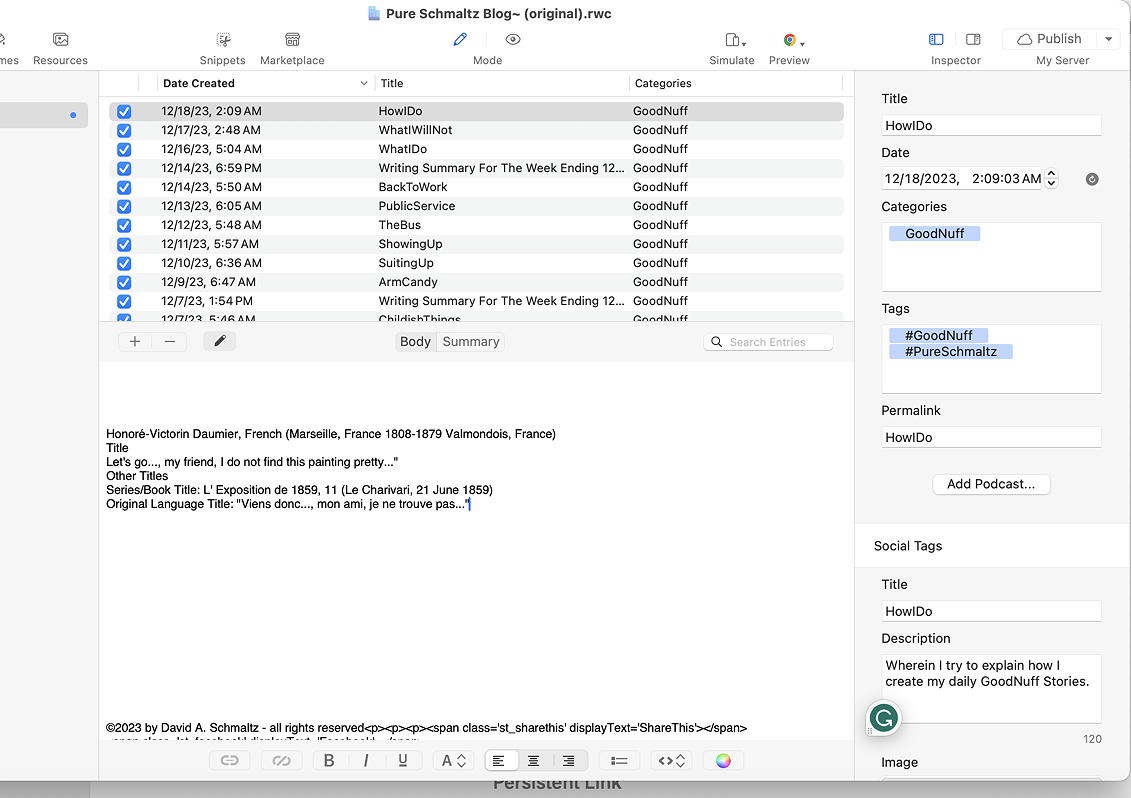
Copying Chosen Image Title into RapidWeaver
I copy the image title into my RapidWeaver application for display in the published version…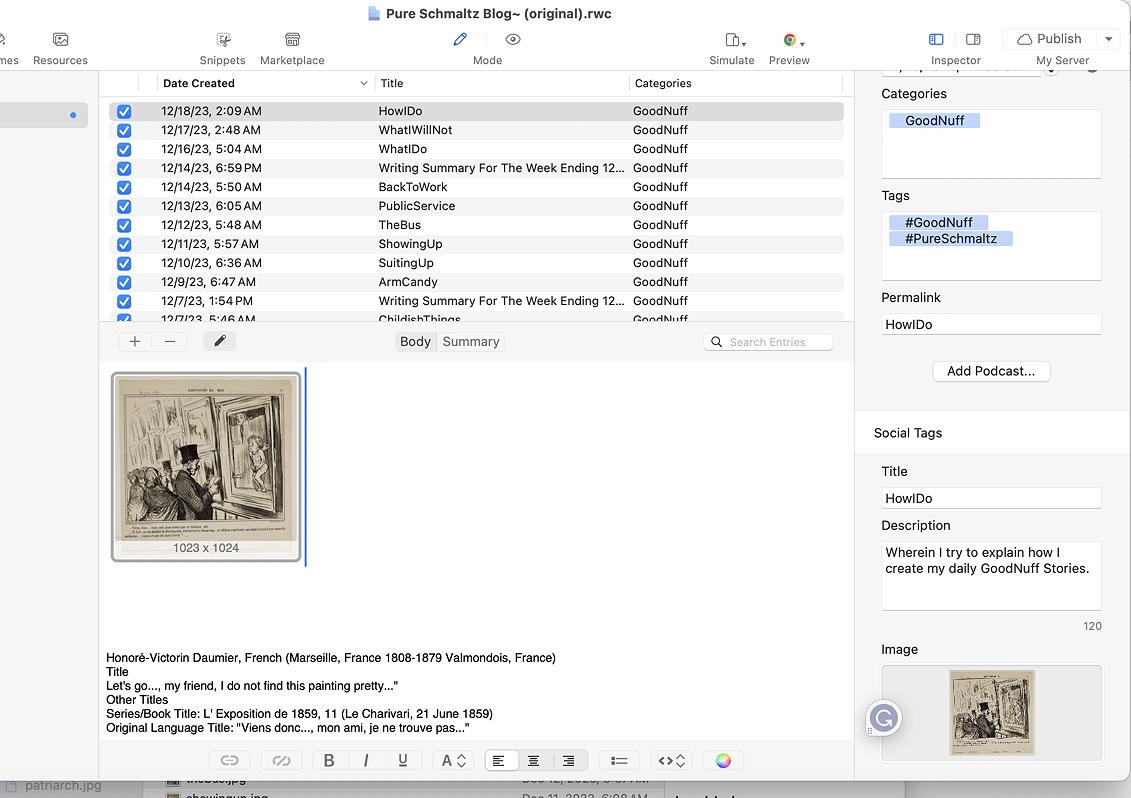
Initial Image Placement
… then save the image. I always manupilate the image size, since many musuems offer HUGE images many megabytes in size and I have limited storage. For my purposes, images need never measure more than 500k, so I shrink their density using the GraphicsConverter12 app. This also converts images into a uniform .jpg file format. I store these images under the story name in a folder containing all the images for that series. Today's image weighs in at 250k (from the original 274k) and I renamed it HowIDo. This allows for easy identification of which image belongs to which story, which will be important in subsequent steps when I copy the story into SubStack and produce an introduction link in my PureSchmaltz Private FaceBook Group. Even writers find themselves forced into consistent accounting practices.
I place the image into the approrpiate RapidWeaver field just above the Image Title.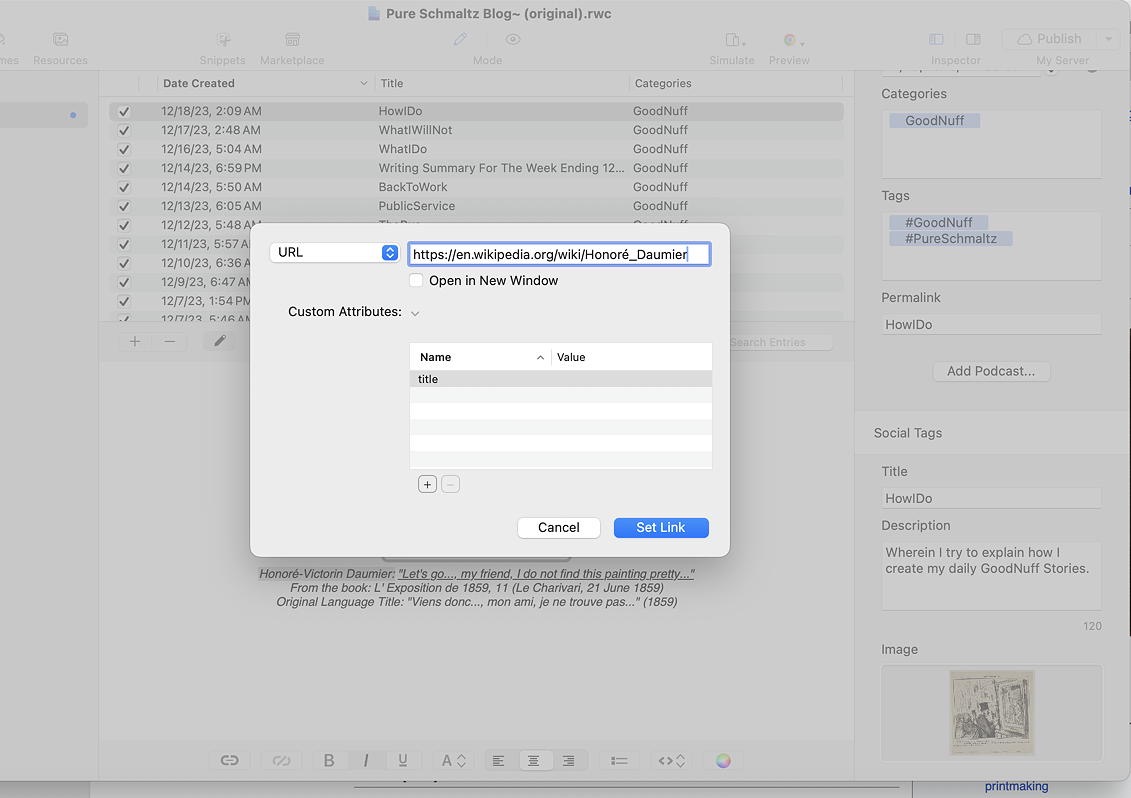
Setting Image and Description Links
I then copy links from the originating image source, in this case it was the Harvard University Art Museum site, and a Wikipedia article about the artist. The image fell out of copyright decades ago but its respectful to cite both the source collection and the artist. I have been acquiring quite an art history orientation by linking these images.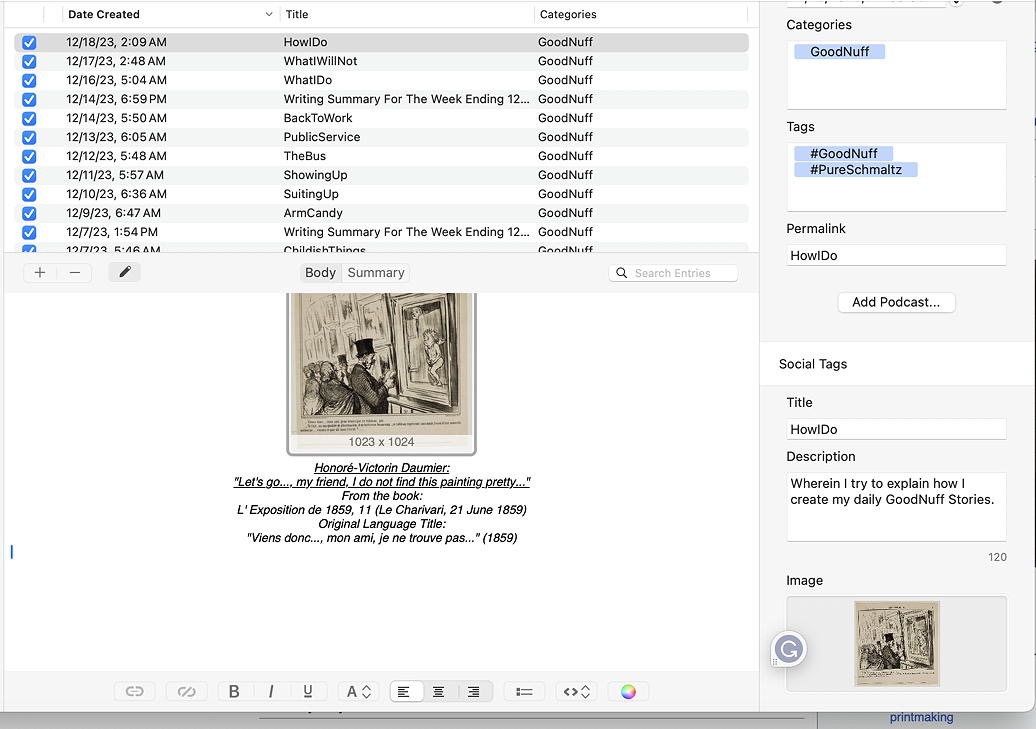
Finally Ready To Write
I then position the image and description by centering them on the page. I preview the resulting display, often fiddling with the description spacing to improve its appearance. Then I'm ready to start writing. I have spent something between a quarter hour and a full hour "just" setting up the space for the day's writing to begin. Through the set up, though, the topic will have been percolating. By the time I finally start writing, I usually feel good and ready, even faunching to begin.
The writing will occur outside of any conscious observer. Once I start writing, time stops. I am no longer fully aware of whatever I'm doing then. I feel suspended slightly outside of space and time. My two-and-a-half typing fingers seem to know the routine, they know the way. I follow. I awaken some time later to start my proofing and final preparation steps. I will consider those stages in the next story in this series.
©2023 by David A. Schmaltz - all rights reserved


